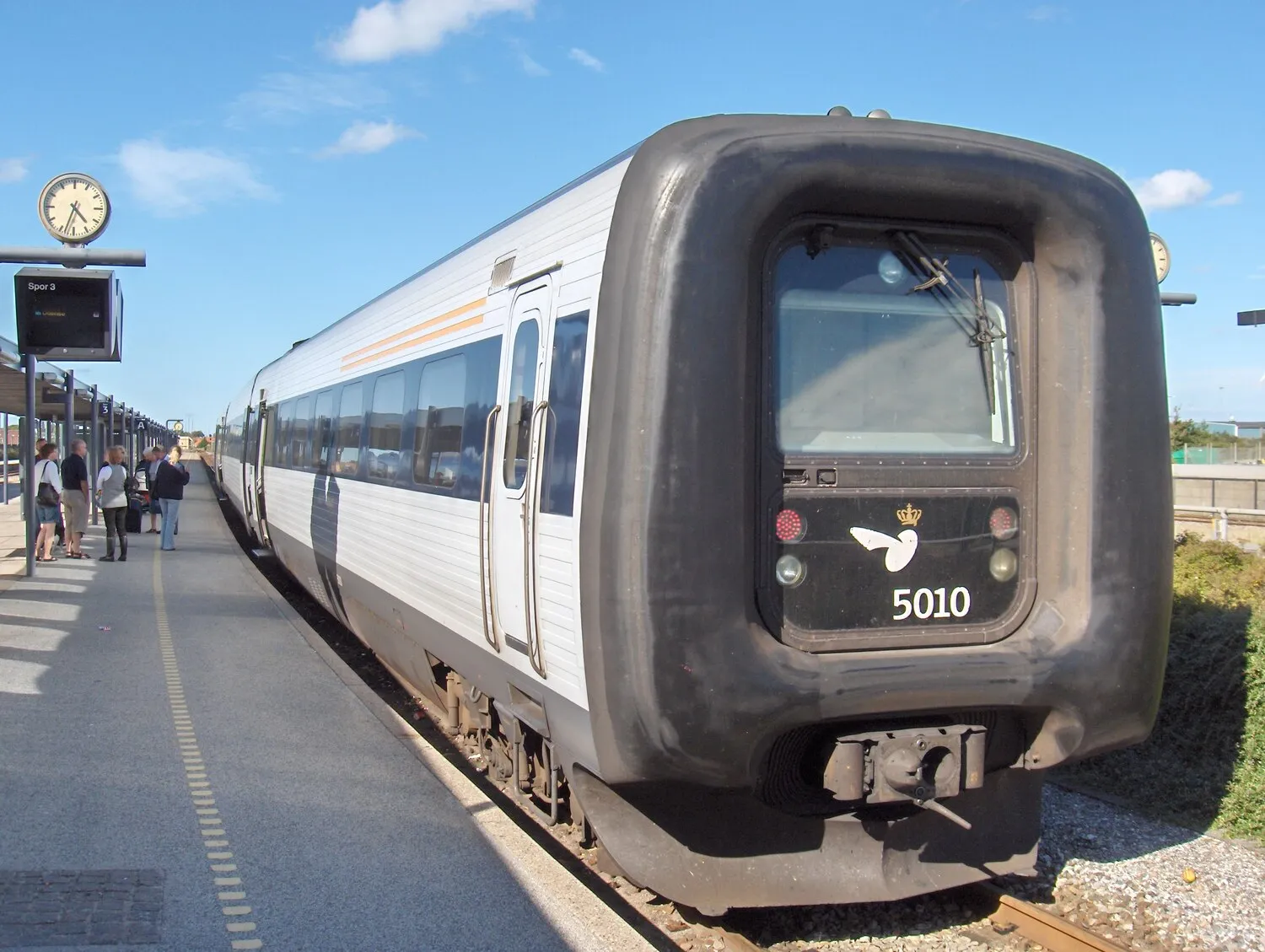
Source: de.wikipedia.org
IC3
Vehicle type:
Registration country:
Railway companies:
1989
The IC3 trains, designed by ABB
Scandia in Randers for the Danske Statsbaner, consists of
three-car diesel multiple units intended for interregional service.
The series saw a further development in 1993 with the introduction
of the IR4, which consists of four-part electric
trains that can be coupled with IC3 units.
A notable feature of the IC3 units is the foldable driver's cab, which can be converted into a passageway, allowing up to five IC3 or IR4 units to be coupled together. Coupling occurs via automatic Scharfenberg couplers with lateral contact surfaces. The intercar connections are airtight due to rubber bellows, which are typically inflated with compressed air to maintain their shape and are deflated for coupling and uncoupling.
Each unit consists of three car bodies: a motor car (MFA), a center car (FF), and another motor car (MFB), supported by four bogies, including two Jacobs bogies. The train is powered by four Deutz diesel engines. Originally equipped with Deutz BF8L513CP engines, which are V8 and air-cooled with a power output of 294 kW each, the units were remotorized starting in 2005 with new TCD2015 V6, water-cooled engines featuring 330 kW each. During this upgrade, the original five-speed automatic transmissions were replaced with new twelve-speed AS Tronic Rail automatic transmissions from ZF Friedrichshafen.
The diesel engines are configured with two A-engines for power supply and two B-engines solely for traction; the units can continue operating even if only one A-engine is functional. The trains feature the ATC train control system for Denmark, while units MF 5076 to 5092 are additionally equipped with PZB 90 for operation in Germany. These units operated EuroCity services on the Vogelfluglinie from Copenhagen to Puttgarden until December 2019. Since 2020, IC services have run from Aarhus via Padborg to Hamburg and from Copenhagen over the Great Belt to Hamburg.
In 2018, a comprehensive refurbishment program was initiated for the trains, which included replacing significant parts of the interior, such as carpets and seats. The investment of 250 million Kroner aims to extend the operational life of the units for an additional ten years. On November 13, 2019, the first six units equipped with ETCS returned to service after upgrades were carried out in collaboration between Banedanmark, supplier Alstom, and DSB.
In 2020, two sets previously retired in Israel were purchased as sources of spare parts and arrived in Grenå on January 21, 2021. The car bodies and bogies were then transferred to Centralværkstedet Aarhus to bolster the spare parts inventory.
The IC3 units operate on various lines in national long-distance traffic and on the intercity line from Fredericia via Padborg to Flensburg, with occasional use on EuroCity routes between Copenhagen and Hamburg. Prior to the opening of the Storebæltsbro on June 14, 1998, the IC3 units functioned in various configurations, including five-unit sets departing from Copenhagen, with units being detached or redirected to ferry services over the Great Belt and subsequent destinations across Jutland.
A notable feature of the IC3 units is the foldable driver's cab, which can be converted into a passageway, allowing up to five IC3 or IR4 units to be coupled together. Coupling occurs via automatic Scharfenberg couplers with lateral contact surfaces. The intercar connections are airtight due to rubber bellows, which are typically inflated with compressed air to maintain their shape and are deflated for coupling and uncoupling.
Each unit consists of three car bodies: a motor car (MFA), a center car (FF), and another motor car (MFB), supported by four bogies, including two Jacobs bogies. The train is powered by four Deutz diesel engines. Originally equipped with Deutz BF8L513CP engines, which are V8 and air-cooled with a power output of 294 kW each, the units were remotorized starting in 2005 with new TCD2015 V6, water-cooled engines featuring 330 kW each. During this upgrade, the original five-speed automatic transmissions were replaced with new twelve-speed AS Tronic Rail automatic transmissions from ZF Friedrichshafen.
The diesel engines are configured with two A-engines for power supply and two B-engines solely for traction; the units can continue operating even if only one A-engine is functional. The trains feature the ATC train control system for Denmark, while units MF 5076 to 5092 are additionally equipped with PZB 90 for operation in Germany. These units operated EuroCity services on the Vogelfluglinie from Copenhagen to Puttgarden until December 2019. Since 2020, IC services have run from Aarhus via Padborg to Hamburg and from Copenhagen over the Great Belt to Hamburg.
In 2018, a comprehensive refurbishment program was initiated for the trains, which included replacing significant parts of the interior, such as carpets and seats. The investment of 250 million Kroner aims to extend the operational life of the units for an additional ten years. On November 13, 2019, the first six units equipped with ETCS returned to service after upgrades were carried out in collaboration between Banedanmark, supplier Alstom, and DSB.
In 2020, two sets previously retired in Israel were purchased as sources of spare parts and arrived in Grenå on January 21, 2021. The car bodies and bogies were then transferred to Centralværkstedet Aarhus to bolster the spare parts inventory.
The IC3 units operate on various lines in national long-distance traffic and on the intercity line from Fredericia via Padborg to Flensburg, with occasional use on EuroCity routes between Copenhagen and Hamburg. Prior to the opening of the Storebæltsbro on June 14, 1998, the IC3 units functioned in various configurations, including five-unit sets departing from Copenhagen, with units being detached or redirected to ferry services over the Great Belt and subsequent destinations across Jutland.
Sources: https://de.wikipedia.org/wiki/DSB_MF
Do you have additional informations regarding this vehicle?
Help us writing the history of IC3! Your knowledge is precious for us and the entire community, do not hesitate to share your facts, photos or videos:
Latest update on the 25th of December 2024 at 20:48
Contributor(s): Tudor C.
Discussion forum


